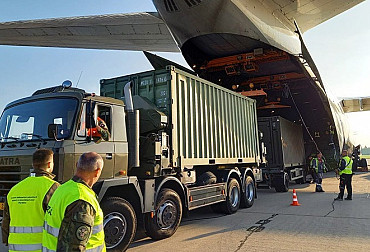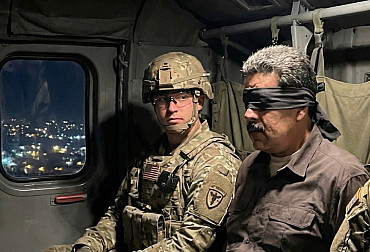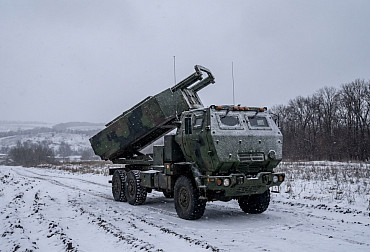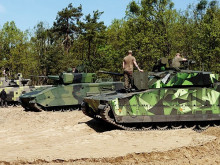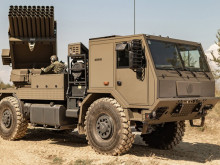Unprecedented technology development and applications are changing the battlespace
We are aware that within a broad strategic and geopolitical context the nature of conflict is being changing and technological transformation of world societies is among significant factors. New technologies bring new opportunities and threats in conflict approaches known as hybrid warfare, hyper-war, memetic warfare or more traditional kinetic use of armed forces. Development and acquisition of military capabilities do not take place in vacuum, as they are driven by technological, individual, economic, societal and organisational needs and trends. In turn, these new, technologically edge driven, military capabilities drive changes in current conflicts and pose fundamentally different challenges for providing security and defence of EU and NATO countries.
 Picture: New technologies bring new opportunities and threats in conflict approaches known as hybrid warfare, hyper-war, memetic warfare or more traditional kinetic use of armed forces | Shutterstock
Picture: New technologies bring new opportunities and threats in conflict approaches known as hybrid warfare, hyper-war, memetic warfare or more traditional kinetic use of armed forces | Shutterstock
We should not close our eyes to the fact that that the conflict is enduring. But we should also understand that the nature of that conflict continues to change, driven in no small measure by advances in technology, tools and scientific understanding. This evolution will be a vital feature of the future battlespace or zones of conflict, whether physical or virtual.
What is the impression of the impact that current technological development has on security, defines and conflict? What is important and what challenges we have to face to keep EU and NATO military technology edge over our peer competitors? What we do and what we should do more not to be technologically outrun in a mid-term and long-term future?
We asked these question NATO Chief Scientist Dr. Bryan Wells, and Chief Executive of the European Defence Agency, Dr. Jiří Šedivý.
Dr. Bryan Wells, NATO Chief Scientist
 Picture: Dr. Bryan Wells, NATO Chief Scientist | Dr. Bryan Wells Archive
Picture: Dr. Bryan Wells, NATO Chief Scientist | Dr. Bryan Wells Archive
NATO has been researching cutting edge science for decades. Its network of national experts – now some 5,000 strong – work together, sharing their knowledge and expertise to maintain the technological edge of the Alliance.
Technology is Changing the Battlespace
In March 2020 the NATO Science and Technology Organization published its Science and Technology Trends 2020-2040. This provides a detailed scientific projection of the likely development of each of Emerging and Disruptive Technologies: Big Data, Artificial Intelligence, Quantum Technologies, Space Technologies, Hypersonics, Biotechnology and Human Enhancement, and Novel Materials and Manufacturing. We have passed copies to the European Defence Agency and the European Commission, and it has been a great pleasure for me to discuss it with my colleagues in both Organisations.
If we look at a more strategic level than individual technologies, we find a number of common characteristics of these emerging and disruptive technologies.
Civil technology development dominates over the military one
The first is that unlike in the past, these technologies are not all the preserve of the Defence Sector. Civil sector investment in these technologies dwarfs that of the defence sector. This means that defence no longer controls the future direction of technology development.
One single technology does not bring game-changing military capability
The second characteristic is that combinations of EDTs are necessary to achieve military effect. The combination of AI, Big Data and Autonomy is a particularly all-pervasive disruptor – it provides the basis for intelligent, autonomous operations across all domains.
The third characteristic is that the breadth of technology change is as important as its pace. We often talk of the speed of technological progress, but we should also pause to reflect on the sheer scale of modern technology. This means that there can be different ways in which the science can support the achievement of a specific military effect. But it also means that it can be difficult even for countries with large defence research organizations to cover all possibilities. This is a further reason why international collaboration in science is so important.
Technology and human factor … future of the autonomy
The final common characteristic I would list is that emerging and disruptive technologies are making human-machine interactions of escalating importance. Science is gaining an ever-better understanding of the human mind, and this will drive breakthroughs in cognitive dominance.
What will these new technologies mean for military capabilities? I would argue – again at the strategic level – that new technologies will give future military capabilities four over-arching characteristics: they will be increasingly intelligent, interconnected, distributed and digital.
Intelligent technologies will explore Artificial Intelligence, and new analytic capabilities to provide novel disruptive applications. Advanced analytical methods are drawing on mathematical breakthroughs to provide fresh insights.
Interconnected technologies will exploit massive networks in and across virtual and physical domains. This will include networks of sensors, linking organizations, individuals, and autonomous agents. The links will use encryption methods such as blockchain and quantum key distribution.
Distributed technologies will employ decentralised and large-scale sensing, computation and manufacturing. This digital manufacturing will exploit AI-assisted design, novel materials, and 3D and even 4D printing technologies.
And digital technologies will produce novel disruptive effects from digitally blended human and information domains. Digital Twins will be increasingly important.
Application of new technologies will change the nature of the battlespace
Emerging and Disruptive Technologies – by changing the nature of military capabilities – will in turn change the nature of the battlespace. We will see greater intelligent autonomous action, an increased importance of cognitive dominance, the presence of expanded warfare domains, and a greater emphasis on precision warfare.
On autonomous action, we have seen autonomous and intelligent systems already supplanting and exceeding the capabilities of humans. This trend will increase, and decision speeds will reach levels that will require new methods of human-machine interaction.
In cognitive dominance we will see the collection of huge amounts of data and very rapid analysis to provide military personnel with options for decision.
The domain of warfare will expand to include the biological domain, contributing genetic modifications, and even living sensors. Technology will enable more effective human-enhancement across the cognitive, social, and physiological domains.
Finally, precision warfare will be enhanced by digitization across capabilities, along with miniaturization and computing improvements.
Defence science and technology continues to evolve and the NATO Science and Technology Organization is constantly watching new evolutions, working to understand them and assessing their military meaning. It is always a great pleasure to engage with Jiří Šedivý as we work on these important issues.
Dr. Jiří Šedivý, EDA Chief Executive
 Picture: Dr. Jiří Šedivý, EDA Chief Executive | Dr. Jiří Šedivý Archive
Picture: Dr. Jiří Šedivý, EDA Chief Executive | Dr. Jiří Šedivý Archive
There is a common understanding nowadays that Europe needs to do more for its own security and defence; even the US start to acknowledge this provided it does not undermine NATO which, needless to say, remains the cornerstone of Europe’s security and defence. But what is required for Europe to take more responsibility in defence and even - let’s be ambitious - become a security provider on a regional and global scale? I see two main prerequisites for that to happen, both of which are true challenges intrinsically linked to the European Defence Agency’s core mission and activities: cooperation and innovation.
There is need for deeper cooperation, better spending
Cooperation is the only way forward to make Europe a global player, especially in the security and defence realm, as none of its countries has the resources and capabilities to ensure stability and security on its own – not for itself and even less so for the whole of Europe. Hence the need to join forces and invest more, and better, in defence. But more spending does not automatically guarantee more efficiency or interoperability. To achieve that, Europeans must plan and invest better through cooperation: from joint priority setting to development, procurement, and deployment of cutting-edge capabilities. Over recent years, EU Member States have put in place a defence planning framework at European level with the Capability Development Plan (CDP), the Coordinated Annual Review on Defence (CARD), the Permanent Structured Cooperation (PESCO) and the European Defence Fund (EDF). This is an achievement. But having cooperation tools in place is not enough; they must also be systematically used to make EU defence cooperation the norm. But even then, the real proof of the pudding is in the eating: cooperation must lead to concrete projects which must produce outcome, i.e. usable defence capabilities. Several cooperation platforms are available to do that, including EDA which has gained robust expertise and track-record in initiating and managing collaborative capability programmes. PESCO is another framework for cooperation for the 25 EU Member States which participate in it. Finally, the EDF must serve as a financial incentive and co-finance such collaborative projects.
Systematic defence cooperation is thus a first box Europe must tick if it wants to shoulder more responsibilities in defence and become a security provider.
Defence innovation or defence irrelevance
Secondly, the EU must also be able to master cutting-edge technologies and their integration into defence products. To do that, it must be at the forefront of defence innovation. Right now, unfortunately, this is not the case: Europe is still lagging in terms of researching, developing and applying high-tech for defence purposes, and it is even further losing ground in relation to the US, China and other powers who invest heavily in it. With the rapid development of new and often disruptive technologies in the civilian world and their fast weaponization - Artificial Intelligence (AI), big data, robotisation, autonomous systems, nanotechnology, digitisation, human-machine factor coupling, biotechnology and hypersonic technologies to name only them - today, more than ever before, innovation has become a geostrategic factor that shapes the international security environment and, eventually, global balance of power. Therefore, our choice, the vital choice for Europe, is clear: defence innovation or defence irrelevance!
To fully embrace defence innovation, the EU and its Member States need to do much more. And we must do much more together, because joint innovation activities, done in collaboration, guarantee better value for money than today’s fragmented efforts. The good news is that our Member States have understood this - and they are ready to act.
Hub for European Defence Innovation
EDA is set to play a key role in that ambition. Indeed, in May 2021, EU Foreign Minister called for a reinforcement of the Agency’s role in fostering defence innovation, including disruptive technologies. Then, in November, we had Defence Ministers debating this topic where the idea of setting up a Hub for European Defence Innovation within EDA was discussed. Since then, this proposal has gained traction and support from more and more Member States, and we hope that a political decision in favour of such a hub at EDA can be made in the coming months.
Let’s be clear: we are not talking here about creating an EU-type ‘DARPA’ (the US super-agency) or turning EDA solely into a ‘European Defence Innovation Agency’, because this would be neither relevant nor realistic in the short term. Rather, EDA should complement and support national bodies by bringing Member States’ defence innovation bodies together, by serving as a network of all existing national innovation centres around Europe and promoting synergies with the industrial sector. Because Europe's problem is not so much that there no or little technological potential, on the contrary. Some of our Member States have very efficient research communities in many technological sectors, but the whole innovation effort is very fragmented, and this is a problem. So, it’s all about connecting the dots and creating synergies. That is why EDA, as the European platform for defence cooperation, is the right place to host the innovation hub and enable those synergies. Of course, all this will be done in close coordination with the European Commission or future NATO innovation structures.
In parallel, EDA continues of course to initiate and manage collaborative defence research and technology (R&T) projects as we have been doing since 2004. Right now, numerous Agency projects deal with the impact of disruptive technologies on the future battlefield. Take AI, for example, which can be used to support the decision-making of commanders, control swarms of drones or to simulate an opponent in training. Other projects are related to hypersonic systems, the use of concentrated energy and lasers for the military, new materials or 3D printing to produce spare parts at the site of operations, to name only them.
To conclude, Europe will only become a relevant and credible security and defence player if Member States join their forces to innovate, plan, develop, produce and use together the top-notch defence capabilities they will need in the future. Cooperation and innovation must go hand in hand - and both are at the very heart of EDA’s work.











